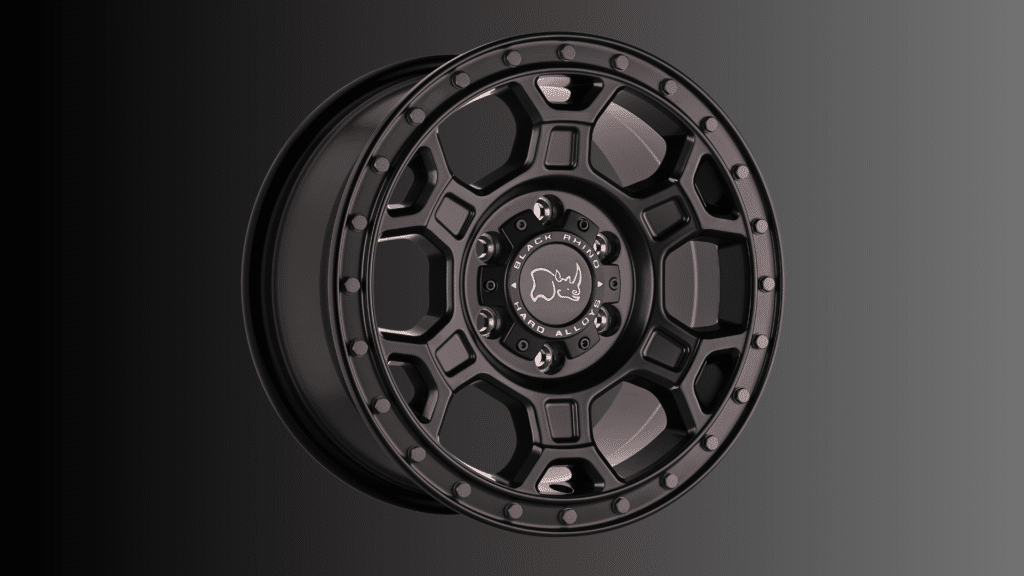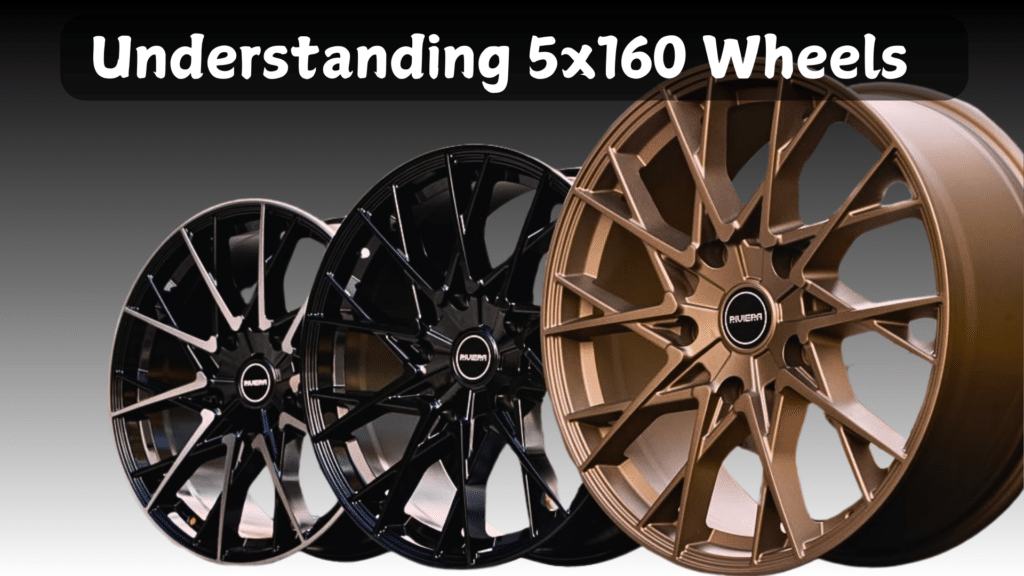When you’re looking for new wheels for your vehicle, the numbers and measurements can feel overwhelming.
The 5×160 wheel pattern is a bolt layout common in certain Ford vans and larger vehicles.
Getting these specifications right is crucial—nobody wants to order wheels only to find they don’t fit.
You probably have questions about the measurements, which vehicles use this pattern, and how to ensure you make the right choice.
That’s completely normal – wheel fitment can be tricky.
This guide will walk you through everything about 5×160 wheels in simple terms. You’ll learn:
- What the numbers mean
- Which vehicles use this pattern
- Important measurements to consider
As auto parts specialists with 15+ years of experience, we’ve helped thousands of vehicle owners make informed wheel choices.
Let’s make this simple together.
Understanding the 5×160 Wheels

Let me break down what 5×160 means in simple terms.
When you see “5×160” on a wheel listing, each number tells you something specific:
- The “5” shows how many bolt holes the wheel has
- The “160” tells you the circle diameter in millimeters
How to Measure a Bolt Pattern
Think of the bolt holes forming a circle on your wheel.
I measure from the center of one bolt hole to the center of the hole directly across from it.
This gives us the “160” part of the measurement.
It’s like measuring across a pizza to find its size.
Why These Numbers Matter
If you buy wheels with the wrong bolt pattern, they won’t fit your vehicle – it’s like trying to use the wrong key in a lock.
Getting it right the first time saves you time and money.
Common Vehicles Using 5×160
You’ll find this pattern on several vehicles:
- Ford Transit vans (2015 and newer)
- Some Mercedes-Benz Sprinter models
- Certain commercial fleet vehicles
Quick Tip: Before buying new wheels, I always suggest double-checking your vehicle’s bolt pattern.
You can measure it yourself or look up your vehicle’s specifications in the owner’s manual.
Features to Look for in 5×160 Wheels
Let me help you understand what really matters when picking your wheels.
I’ve spent years working with different wheel types, and here’s what you need to know:
Key Measurements That Matter
The wheel’s diameter affects how your vehicle handles and looks.
Common sizes range from 16 to 20 inches.
Bigger isn’t always better—it depends on what you need.
Understanding Offset
The offset tells you how your wheel sits in the wheel well:
- Positive offset: The wheel sits closer to your vehicle
- Zero offset: The wheel sits in the middle
- Negative offset: Wheel sticks out more
Load Ratings Matter
Your wheels need to handle your vehicle’s weight.
A work van needs stronger wheels than a passenger vehicle.
Check the load rating before buying – it’s marked on the wheel.
Materials Make a Difference
Steel Wheels
- Cost less
- Handle heavy loads well
- Work great for work vehicles
- Tend to be heavier
- Basic looking
Alloy Wheels
- Weigh less
- Help your brakes work better
- Cost more
- Look nicer
- Need more care
Finish Options
You can pick from:
- Painted (good for daily use)
- Polished (shiny but needs regular cleaning)
- Machined (two-tone look)
- Black (hides brake dust better)
Quick Tip: I always tell customers to match their wheel choice to how they’ll use their vehicle.
For example, a delivery van needs wheels that are different from a camper van’s.
Popular Vehicle Models That Use 5×160 Wheels
Ford Transit Models
- Transit 150 (2015 and up)
- Transit 250 (2015 and up)
- Transit 350 (2015 and up)
These vans come in different heights and lengths, but they all use the same bolt pattern.
I see them used a lot as work vans and camper conversions.
Mercedes-Benz Vehicles
- Sprinter 2500 (select years)
- Sprinter 3500 (select years)
Work and Commercial Uses
Many fleet vehicles use this wheel pattern because it works well for:
- Delivery services
- Construction companies
- Moving companies
- Mobile businesses
Off-Road and Camping
I’ve noticed more people using these vehicles for:
- Camper van builds
- Mobile homes
- Weekend getaway vehicles
Remember: Always check your specific model year.
Even within the same vehicle line, patterns can change over the years.
Benefits of Upgrading to 5×160 Wheels
Let me share what I’ve seen first-hand about upgrading wheels.
Your choice can make a real difference in your vehicle’s performance and appearance.
Better Performance
I’ve noticed these improvements when people upgrade their wheels:
- Better braking due to lighter wheel weight
- Smoother rides from better-made wheels
- Stronger grip on different road types
- Better load support for heavy cargo
Style Changes
New wheels can make your van or truck look different:
- Clean, modern designs
- Fresh finishes that match your paint
- Wider stance options
- Custom sizes that fill wheel wells better
Long-Term Value
Quality wheels last longer. Here’s what I’ve seen:
- Less wear on tires
- Fewer replacements needed
- Better resale value
- Lower maintenance costs
Real-World Uses
Different wheels help with specific needs:
- Carrying heavy loads
- Long-distance driving
- City deliveries
- Weekend camping trips
Comparing 5×160 Wheels to Other Bolt Patterns
Let me break down the differences between common bolt patterns in a simple table.
I’ve worked with all these patterns and can help you understand what sets each one apart.
| Feature | 5×160 Pattern | 5×114.3 Pattern | 6×139.7 Pattern |
|---|---|---|---|
| Vehicle Types | Large vans, commercial vehicles | Passenger cars, SUVs | Trucks, large SUVs |
| Load Rating | Higher (up to 4,000 lbs per wheel) | Medium (2,000-3,000 lbs per wheel) | High (3,500+ lbs per wheel) |
| Wheel Size Options | 16-20 inches common | 15-22 inches common | 16-24 inches common |
| Main Benefits | Better for heavy loads, commercial use | Good for daily driving, common size | Strong for off-road use |
| Typical Uses | Work vans, campers | Family cars, light SUVs | Pickup trucks, 4x4s |
Using Adapters
Here’s what I tell customers about wheel adapters:
- Pros:
- Let you use wheels with different patterns
- Give more wheel options
- Can be cost-effective
- Cons:
- It may affect wheel balance
- Need regular checks
- Not ideal for heavy loads
How to Maintain and Care for 5×160 Wheels
Let me share some simple tips to keep your wheels in good shape.
I’ve seen wheels last twice as long with proper care.
Basic Cleaning Steps
- Wash wheels when they’re cool
- Use soap made for wheels
- Clean one wheel at a time
- Rinse well with plain water
- Dry with a clean cloth
Weekly Checks
I suggest checking these things every week:
- Look for loose lug nuts
- Check tire pressure
- Look for cracks or dents
- Watch for rust spots
- Notice any strange noises
Lug Nut Care
Proper torque matters a lot. Here’s what to do:
- Check torque monthly
- Use the right torque setting (usually 100-150 ft-lbs)
- Tighten in a star pattern
- Don’t over-tighten
Signs of Trouble
Watch out for:
- Wobbling while driving
- Rust around bolt holes
- Bent or cracked rims
- Uneven tire wear
- Strange vibrations
Seasonal Care
Different seasons need different care:
- Winter: Clean off salt weekly
- Summer: Watch for brake dust buildup
- Spring/Fall: Deep clean and inspect
Quick Tip: I keep a torque wrench in my vehicle. It helps me check lug nuts quickly when I’m on long trips.
Tips for Choosing the Right 5×160 Wheels
Know Your Vehicle’s Needs
Think about how you use your vehicle:
- Daily work van? Focus on strength
- Weekend camper? Balance looks and function
- Delivery vehicle? Pick easy-to-clean options
- Family transport? Safety comes first
Check These Numbers First
I always tell customers to write down:
- Vehicle’s weight
- Maximum load needs
- Current tire size
- Wheel well spaced
- Your budget range
Talk to Someone Who Knows
Before buying:
- Visit a wheel shop
- Read your owner’s manual
- Ask other vehicle owners
- Check online forums
- Get a second opinion
Common Mistakes to Avoid
I’ve seen people run into these issues:
- Buying just for looks
- Picking the cheapest option
- Not checking load ratings
- Skipping professional help
- Missing warranty info
Budget Smart
Plan for all costs:
- Wheel price
- New tires if needed
- Installation fees
- Balancing costs
- Regular maintenance
Remember: Getting the right wheels the first time saves money and keeps you safe.
Don’t rush your choice.
Conclusion
5×160 wheels are key in many vehicles, from work vans to campers.
I’ve seen how the right wheels make a real difference in performance and safety.
Remember these main points:
- Pick wheels that match your daily use
- Keep up with basic maintenance
- Get professional help when needed
Quality wheels last longer and work better.
Don’t cut corners on research or installation. Your safety depends on these five bolts and their pattern.
Need help picking the right wheels?
Talk to a wheel specialist or check your owner’s manual.
Share your experiences and learn from others who switched to 5×160 wheels.
Frequently Asked Questions
How Often Should I Rotate 5×160 Wheels?
Rotate your wheels every 5,000-7,000 miles to ensure even wear and extend their life.
Are 5×160 Wheels More Expensive than Other Patterns?
Yes, they often cost more because they’re made for specific commercial vehicles and need higher-quality materials.
Can I Paint My 5×160 Wheels?
Yes, but use proper wheel paint and primer.
Professional painting gives better, longer-lasting results.


